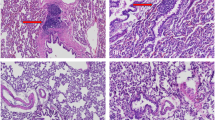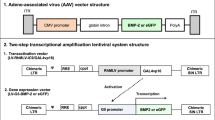Abstract
In order to adapt ex vivo regional gene therapy for clinical applications in orthopaedic surgery, safety issues must be considered. In this study we developed a suicide approach using a dual gene expression two step transcriptional amplification lentiviral vector (LV-TSTA) encoding BMP-2 and an inducible caspase 9 (iC9) system that selectively induces apoptosis upon activation with a chemical inducer of dimerization (CID). Transduction of rat bone marrow stromal cells (RBMSCs) with LV-TSTA-iC9/BMP-2 led to abundant BMP-2 production (90.3 ± 7.9 ng/24 h/106 cells) in vitro and stimulated bone formation in a mouse muscle pouch in the absence of CID. Moreover it was shown that CID could be used to selectively induce apoptosis in iC9-transduced cells both in vitro and in vivo. Double exposure to serial dilutions of CID decreased in vitro production of BMP-2 by 85–87% and Luc activity by 97–99% in iC9/BMP-2 or iC9/Luc-transduced cells respectively. Early administration of CID (Days 0–1 post-op) in mice implanted with iC9/BMP-2-transduced RBMSCs was effective in blocking bone formation, indicating that CID was toxic to the transduced cells. In iC9/Luc-implanted mice, late administration of two doses of CID (Days 27–28 post-op) significantly reduced the luciferase signal. The current study provides proof of concept for the potential clinical application of regulated gene therapy to promote bone repair.
This is a preview of subscription content, access via your institution
Access options
Subscribe to this journal
Receive 12 print issues and online access
$259.00 per year
only $21.58 per issue
Buy this article
- Purchase on Springer Link
- Instant access to full article PDF
Prices may be subject to local taxes which are calculated during checkout









Similar content being viewed by others
References
Bougioukli S, Evans C, Alluri R, Ghivizzani S, Lieberman J. Gene therapy to enhance bone and cartilage repair in orthopaedic surgery. Curr Gene Ther. 2018;18:154–70.
Evans CH, Huard J. Gene therapy approaches to regenerating the musculoskeletal system. Nat Rev Rheumatol. 2015;11:234–42.
Bokhoven MC. Measurement of insertional mutagenesis by retroviral and lentiviral vectors. Doctoral thesis. University of London; 2008.
Garrison KR, Shemilt I, Donell S, Ryder JJ, Mugford M, Harvey I, et al. Bone morphogenetic protein (BMP) for fracture healing in adults. Cochrane Database Syst Rev. 2010;6:CD006950.
Fan L, Freeman KW, Khan T, Pham E, Spencer DM. Improved artificial death switches based on caspases and FADD. Hum Gene Ther. 1999;10:2273–85.
Straathof KC, Pulè MA, Yotnda P, Dotti G, Vanin EF, Brenner MK, et al. An inducible caspase 9 safety switch for T-cell therapy. Blood. 2005;105:4247–54.
Yagyu S, Hoyos V, Del Bufalo F, Brenner MK. An inducible caspase-9 suicide gene to improve the safety of therapy using human induced pluripotent stem cells. Mol Ther. 2015;23:1475–85.
Ramos CA, Asgari Z, Liu E, Yvon E, Heslop HE, Rooney CM, et al. An inducible caspase 9 suicide gene to improve the safety of mesenchymal stromal cell therapies. Stem Cells. 2010;28:1107–15.
Tey SK, Dotti G, Rooney CM, Heslop HE, Brenner MK. Inducible caspase 9 suicide gene to improve the safety of allodepleted T cells after haploidentical stem cell transplantation. Biol Blood Marrow Transplant. 2007;13:913–24.
Alvarez-Urena P, Zhu B, Henslee G, Sonnet C, Davis E, Sevick-Muraca E, et al. Development of a cell-based gene therapy approach to selectively turn off bone formation. J Cell Biochem. 2017;118:3627–34.
Zhou X, Di Stasi A, Brenner MK. iCaspase 9 suicide gene system. Methods Mol Biol. 2015;1317:87–105.
Virk MS, Sugiyama O, Park SH, Gambhir SS, Adams DJ, Drissi H, et al. “Same day” ex-vivo regional gene therapy: a novel strategy to enhance bone repair. Mol Ther. 2011;19:960–8.
Bougioukli S, Sugiyama O, Pannell W, Ortega B, Tan MH, Tang AH, et al. Gene therapy for bone repair using human cells: superior osteogenic potential of BMP-2 transduced mesenchymal stem cells derived from adipose tissue compared to bone marrow. Hum Gene Ther. 2018;29:507–19.
Alaee F, Bartholomae C, Sugiyama O, Virk MS, Drissi H, Wu Q, et al. Biodistribution of LV-TSTA transduced rat bone marrow cells used for “ex-vivo” regional gene therapy for bone repair. Curr Gene Ther. 2015;15:481–91.
Vakhshori V, Bougioukli S, Sugiyama O, Tang A, Yoho R, Lieberman JR. Cryopreservation of human adipose-derived stem cells for use in ex vivo regional gene therapy for bone repair. Hum Gene Ther Methods. 2018 Oct 25. https://doi.org/10.1089/hgtb.2018.191. [Epub ahead of print]
Hsu WK, Sugiyama O, Park SH, Conduah A, Feeley BT, Liu NQ, et al. Lentiviral mediated BMP-2 gene transfer enhances healing of segmental femoral defects in rats. Bone. 2007;40:931–8.
Pensak M, Hong S, Dukas A, Tinsley B, Drissi H, Tang A, et al. The role of transduced bone marrow cells overexpressing BMP-2 in healing critical-sized defects in a mouse femur. Gene Ther. 2015;22:467–75.
Guan J, Zhang J, Zhu Z, Niu X, Guo S, Wang Y, et al. Bone morphogenetic protein 2 gene transduction enhances the osteogenic potential of human urine-derived stem cells. Stem Cell Res Ther. 2015;6:5.
Qing W, Guang-Xing C, Lin G, Liu Y. The osteogenic study of tissue engineering bone with BMP2 and BMP7 gene-modified rat adipose-derived stem cell. J Biomed Biotechnol. 2012;2012:410879.
Carragee EJ, Hurwitz EL, Weiner BK. A critical review of recombinant human bone morphogenetic protein-2 trials in spinal surgery: emerging safety concerns and lessons learned. Spine J. 2011;11:471–91.
Woo EJ. Adverse events after recombinant human BMP2 in nonspinal orthopaedic procedures. Clin Orthop Relat Res. 2013;471:1707–1011.
Chen M, Orozco A, Spencer DM, Wang J. Activation of initiator caspases through a stable dimeric intermediate. J Biol Chem. 2002;277:50761–7.
Zhou X, Brenner MK. Improving the safety of T-Cell therapies using an inducible caspase-9 gene. Exp Hematol. 2016;44:1013–9.
Di Stasi A, Tey SK, Dotti G, Fujita Y, Kennedy-Nasser A, Martinez C, et al. Inducible apoptosis as a safety switch for adoptive cell therapy. N Engl J Med. 2011;365:1673–83.
Zhou X, Di Stasi A, Tey SK, Krance RA. Martinez C1, Leung KS et al. Long-term outcome after haploidentical stem cell transplant and infusion of T cells expressing the inducible caspase 9 safety transgene. Blood. 2014;123:3895–905.
Zhou X, Dotti G, Krance RA, Martinez CA, Naik S, Kamble RT, et al. Inducible caspase-9 suicide gene controls adverse effects from alloreplete T cells after haploidentical stem cell transplantation. Blood. 2015;125:4103–13.
Zhou X, Naik S, Dakhova O, Dotti G, Heslop HE, Brenner MK. Serial Activation of the inducible caspase 9 safety switch after human stem cell transplantation. Mol Ther. 2016;24:823–31.
Iuliucci JD1, Oliver SD, Morley S, Ward C, Ward J, Dalgarno D, et al. Intravenous safety and pharmacokinetics of a novel dimerizer drug, AP1903, in healthy volunteers. J Clin Pharmacol. 2001;41:870–9.
Kaplan RN. National Cancer Institute (NCI). A phase I trial of T cells expressing an anti-GD2 chimeric antigen receptor in children and young adults with GD2+Solid tumors. https://clinicaltrials.gov/ct2/show/NCT02107963?term=Caspase&cond=Sarcoma&rank=1. Accessed 17 Jun 2018.
Heczey A. 3rd generation GD-2 chimeric antigen receptor and icaspase suicide safety switch, neuroblastoma, GRAIN (GRAIN). https://clinicaltrials.gov/ct2/show/NCT01822652. Accessed 17 Jun 2018.
Feeley BT, Conduah AH, Sugiyama O, Krenek L, Chen IS, Lieberman JR. In vivo molecular imaging of adenoviral versus lentiviral gene therapy in two bone formation models. J Orthop Res. 2006;24:1709–21.
Sugiyama O1, An DS, Kung SP, Feeley BT, Gamradt S, Liu NQ, et al. Lentivirus-mediated gene transfer induces long-term transgene expression of BMP-2 in vitro and new bone formation in vivo. Mol Ther. 2005;11:390–8.
Acknowledgements
This work was supported by a National Institutes of Health grant to JRL [R01AR057076]. The authors would like to thank Ryan Park and Ivetta Vorobyova of the USC Molecular Imaging Center for their invaluable contribution in microCT and in vivo bioluminescent imaging. We would also like to thank Amy Tang for the histology sections and staining. Finally, special thanks to Dr. David Spencer for his guidance on the iC9/CID system.
Author information
Authors and Affiliations
Contributions
SB participated in project development, and conducted the animal surgeries, plain radiographs, histomorphometry, data analysis and interpretation, and manuscript preparation. VV participated in project development, assisted in animal surgeries and imaging, data interpretation, and manuscript editing. BO participated in project development, generated the vectors, performed the in vitro experiments and edited the final manuscript. OS designed and generated the vectors, performed the transductions and in-vitro experiments, and edited the final manuscript. JRL designed and supervised the study, interpreted the results and edited the manuscript.
Corresponding author
Ethics declarations
Conflict of interest
JRL has received royalties and has served as a paid consultant for Depuy, is a shareholder in Hip Innovation Technologies, Inc and has received royalties, financial or material support from Elsevier. The remaining authors declare that they have no conflict of interest.
Additional information
Publisher’s note: Springer Nature remains neutral with regard to jurisdictional claims in published maps and institutional affiliations.
Rights and permissions
About this article
Cite this article
Bougioukli, S., Vakhshori, V., Ortega, B. et al. Regulated ex vivo regional gene therapy for bone repair using an inducible caspase-9 suicide gene system. Gene Ther 26, 230–239 (2019). https://doi.org/10.1038/s41434-019-0069-4
Received:
Revised:
Accepted:
Published:
Issue Date:
DOI: https://doi.org/10.1038/s41434-019-0069-4



